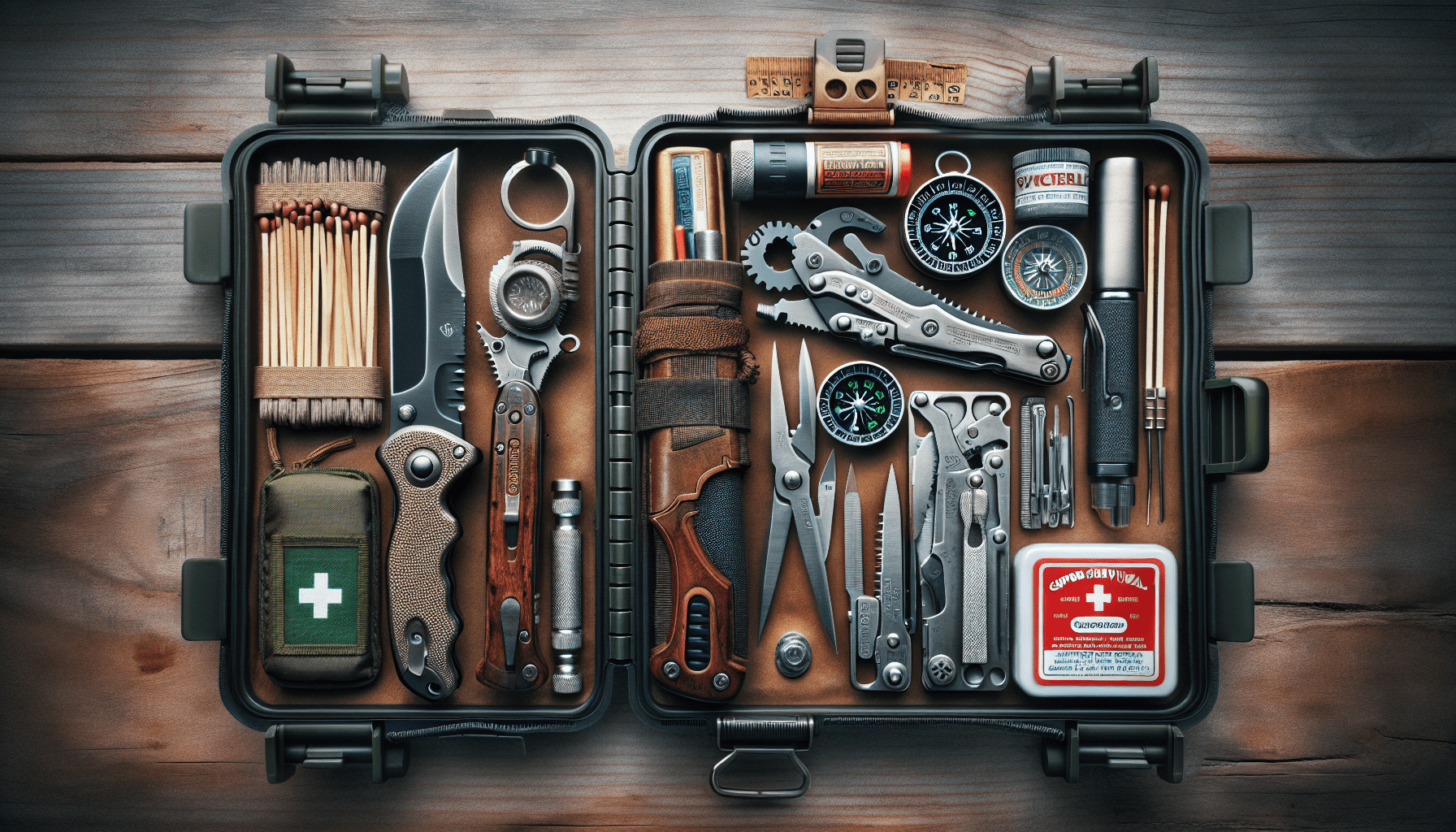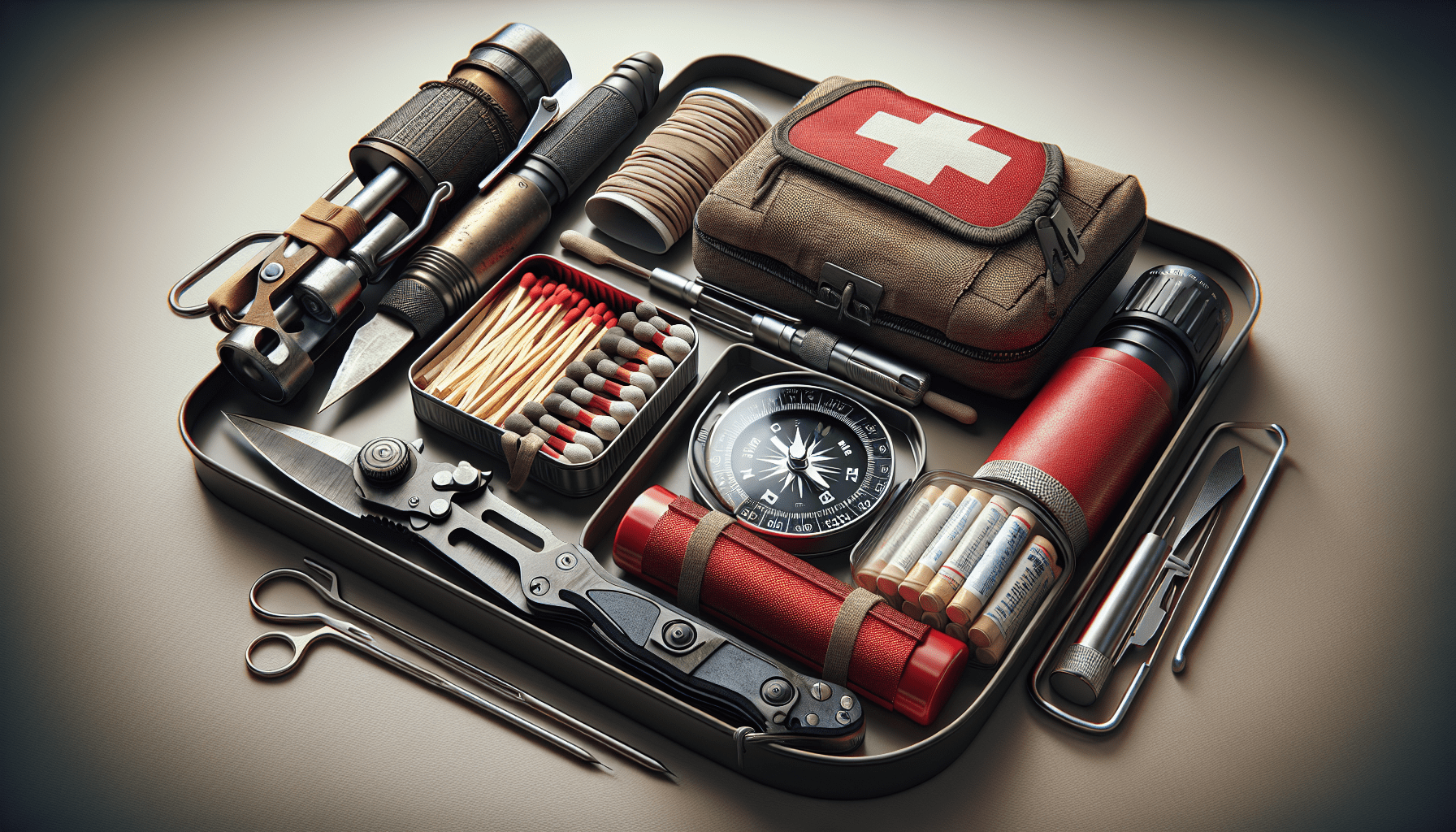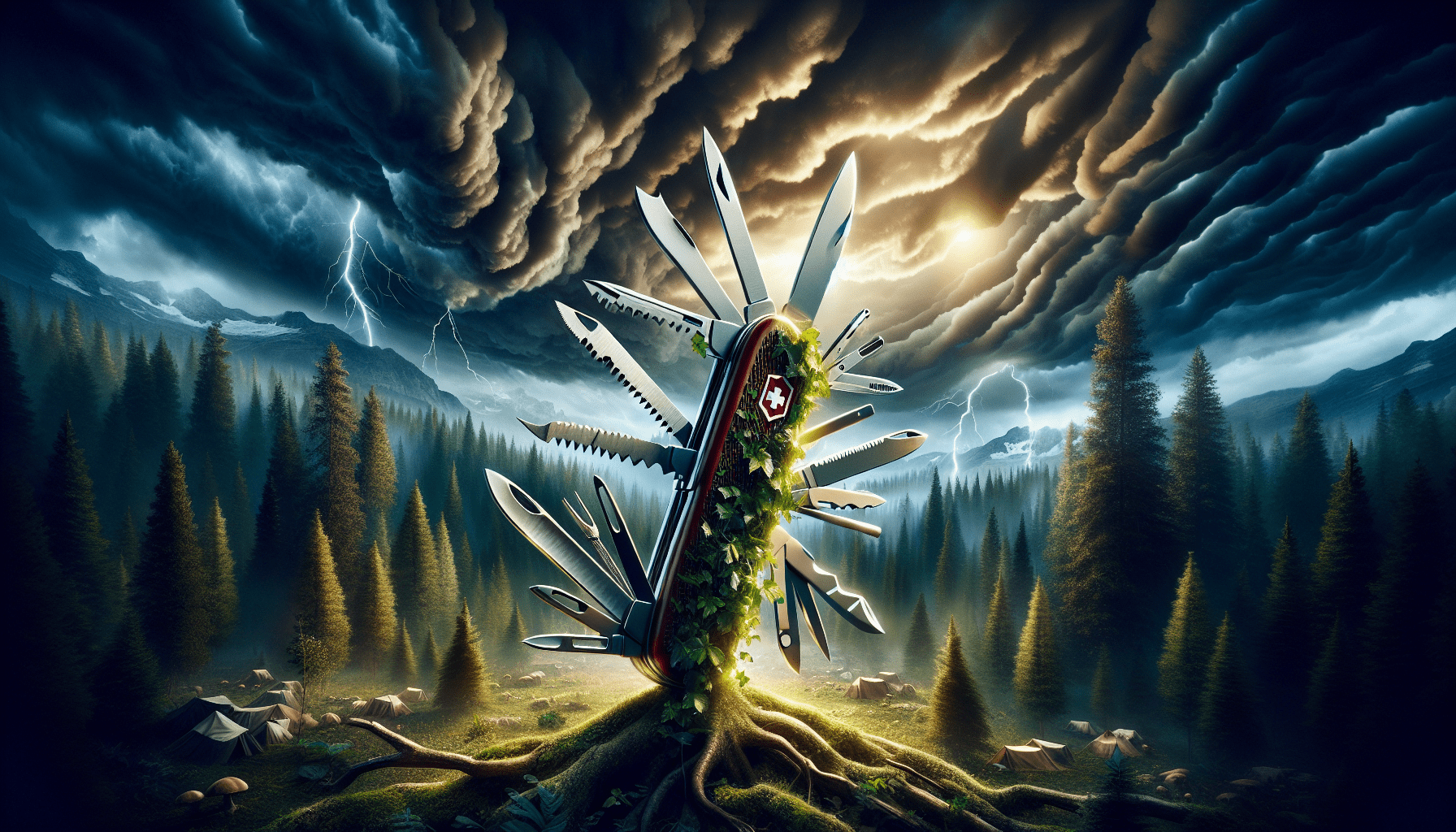What Are 10 Items In A Survival Kit?
What Are 10 Items In A Survival Kit?
Imagine yourself stranded in the middle of nowhere, with no modern conveniences and no one to rely on. Scary, right? That’s why having a well-equipped survival kit is crucial. But what exactly should be in that kit? In this article, we will explore the top 10 essential items that should be included in any survival kit. From tools to food and everything in between, we’ve got you covered. So, let’s dive right in and get you prepared for any unexpected adventure or emergency!
Top 10 Items In A Survival Kit
Water
Water bottles
Having access to clean drinking water is essential in any survival situation. Water bottles are a convenient way to carry and store water when you’re on the go. Look for ones that are durable, leak-proof, and have a large capacity. It’s recommended to have at least one liter of water per person per day in your survival kit.
Water purification tablets
If you run out of clean water or come across a water source that may be contaminated, water purification tablets can be a lifesaver. These compact and lightweight tablets are designed to kill harmful bacteria, viruses, and parasites, making water safe to drink. Follow the instructions carefully when using them to ensure proper purification.
Water filter
In addition to water bottles and purification tablets, having a water filter is a smart idea. A portable water filter can remove harmful contaminants from water sources such as rivers, lakes, and streams. Look for filters that are easy to use, effective in removing bacteria and protozoa, and have a high flow rate. This way, you can have a steady supply of clean drinking water during emergencies.
Food
Non-perishable food items
When it comes to sustenance in survival situations, non-perishable food items are your best bet. These are food items that have a long shelf life and don’t require refrigeration. Options include canned goods, energy bars, dried fruits, nuts, and jerky. Make sure to choose items that are nutritious and provide enough calories to keep you going in case of an emergency.
Meal replacement bars
Meal replacement bars are another convenient and lightweight option to consider for your survival kit. These bars are packed with essential nutrients and calories, making them a great source of sustained energy. Look for bars that are high in protein, fiber, and vitamins to meet your nutritional needs during challenging times.
Canned food
Canned food is a classic option for emergency situations. They have a long shelf life and are ready to eat right out of the can. Be sure to pack a variety of canned goods, such as vegetables, meats, and soups, to diversify your meals. Don’t forget to include a can opener in your kit, as most canned foods will require one for access.

Shelter
Emergency tent
When you find yourself in need of protection from the elements, an emergency tent can provide you with a quick and reliable shelter. These lightweight and easy-to-assemble tents are designed to withstand various weather conditions. Look for one that is made from durable materials and has features like waterproofing and ventilation to ensure your comfort while staying protected.
Emergency blanket
An emergency blanket, also known as a space blanket, is a must-have item in your survival kit. These compact, lightweight blankets are made of reflective material that helps retain your body heat. They are designed to provide insulation and prevent hypothermia in cold conditions. Keep one or more emergency blankets in your kit to stay warm and comfortable during emergencies.
Sleeping bag
A good quality sleeping bag can make all the difference in your comfort and survival during outdoor adventures or emergencies. Look for a sleeping bag that is lightweight, durable, and suitable for the temperature range of your region. Sleeping bags designed for emergency situations often have additional insulation and features to keep you warm in challenging conditions.
Fire
Fire starter
Fire is not only essential for keeping warm but also for cooking food and signaling for help. Including a fire starter in your survival kit is crucial. There are various fire starter options available, such as magnesium fire starters, ferrocerium rods, and waterproof matches. Choose a reliable and easy-to-use fire starter that suits your needs and practice fire-building techniques before you find yourself in a survival situation.
Waterproof matches
Having a supply of waterproof matches is a valuable asset in your survival kit. Unlike regular matches, waterproof matches are designed to ignite even when wet or in damp conditions. These matches often come in a waterproof container to protect them from moisture. Ensure you keep them in a watertight compartment within your kit to guarantee their reliability when needed.
Lighter
A reliable and windproof lighter is a useful addition to your survival kit. Lighters are easy to use and can provide a flame instantly. Opt for a refillable lighter that has a waterproof casing to protect it from the elements. Keep it handy, and make sure it has enough fuel to last for an extended period.

First Aid
Bandages
Injuries can happen in any survival situation, so having a variety of bandages in your kit is essential. Include adhesive bandages of different shapes and sizes, as well as sterile gauze pads and adhesive tape. These items can be used to cover and protect wounds, prevent infections, and promote healing. Familiarize yourself with basic first aid procedures, such as cleaning and dressing wounds, before an emergency arises.
Antiseptic wipes
Antiseptic wipes are a convenient way to clean and disinfect wounds. They help prevent infections by killing bacteria and reducing the risk of contamination. Pack individually wrapped antiseptic wipes in your survival kit for easy access and hygienic wound care. Remember to read the instructions to ensure proper application and follow-up treatment.
Pain relievers
Pain relievers, such as acetaminophen or ibuprofen, can provide temporary relief from aches, pains, and fever. They can be invaluable during a survival situation where medical help may not be immediately available. Pack a small supply of over-the-counter pain relievers in your kit, but be mindful of expiration dates and rotate them regularly to maintain their effectiveness.
Communication
Whistle
A whistle is a simple yet powerful tool for communication during emergencies. Its loud, distinctive sound can be heard from a distance, helping you attract attention and signal for help. Choose a whistle that is lightweight, durable, and preferably made of materials that won’t freeze or corrode in extreme conditions. Keep it easily accessible, either on a lanyard or clipped onto your gear.
Signal mirror
A signal mirror is a highly effective way to attract attention and signal your location to potential rescuers. These mirrors are designed to reflect sunlight in a focused beam that can be seen from miles away. Look for a lightweight and durable signal mirror with a sight hole to aim the reflection accurately. Practice using the mirror to ensure you’re familiar with its capabilities and can use it effectively in an emergency.
Portable radio
Having a portable radio with you can provide crucial information and updates during emergencies. Look for a radio that is battery-powered and has both AM and FM frequencies. Portable radios often have additional features like a flashlight and a built-in smartphone charger, making them versatile tools in survival situations. Pack spare batteries and keep them separate from the radio to conserve power.
Navigation
Compass
A compass is an invaluable tool when it comes to navigation in unfamiliar territories. It can help you determine directions and find your way to safety. Look for a reliable and durable compass with clear markings and a sighting mirror for accurate readings. Familiarize yourself with the basic use of a compass before relying on it in a survival situation.
Map
Having a detailed map of the area you’re in or planning to travel through is crucial for navigation and route planning. Choose a topographic map that includes key features like landmarks, water sources, and elevation changes. Waterproof maps are recommended to protect them from moisture, which can render them unreadable. Study the map and plan alternative routes before your journey.
GPS device
In addition to a compass and map, a GPS device can provide you with precise location information. GPS devices use satellite signals to determine your coordinates, making them highly accurate. Look for a handheld GPS device that is rugged, has a long battery life, and includes features like waypoint tracking and mapping. Familiarize yourself with its functions and keep spare batteries, or a charging option, in your kit.
Tools
Knife
A sturdy and reliable knife is an essential tool in any survival kit. It can be used for various tasks such as cutting, carving, preparing food, and even self-defense. Choose a fixed-blade knife with a full tang (the blade extends through the handle) for maximum strength and durability. Keep it sharp and maintain its edge regularly to ensure its effectiveness.
Multi-purpose tool
A multi-purpose tool, also known as a Swiss Army Knife or a Leatherman, is a versatile addition to any survival kit. These compact tools often come with various functions, including pliers, screwdrivers, scissors, and can/bottle openers. Look for a multi-purpose tool with high-quality construction and the functions you find most useful. Don’t forget to practice using its features before relying on it in an emergency.
Duct tape
Duct tape is a valuable tool with countless applications in survival situations. It can be used for repairing gear, securing shelters, creating bandages, or even constructing tools. Pack a roll of durable and waterproof duct tape in your kit, ensuring it’s sealed to prevent unraveling and moisture damage. Its versatility and strength make it an indispensable resource in challenging circumstances.
Lighting
Headlamp
A headlamp is a practical and hands-free lighting solution that leaves your hands free for other tasks. Look for a headlamp that is lightweight, adjustable, and has a brightness range suitable for your needs. Consider additional features such as a red light mode for preserving night vision and a strobe function for emergency signaling. Keep spare batteries or ensure it has a rechargeable option available.
Flashlight
A reliable flashlight is a must-have item in any survival kit. Opt for a flashlight that is compact, durable, and waterproof. Look for one with adjustable brightness settings and features like a SOS mode or strobe function for emergency signaling. Keep spare batteries or a rechargeable option available, and regularly check the flashlight to ensure it’s in working condition.
Glow sticks
Glow sticks can provide a reliable source of light during emergencies, especially in situations where batteries may not be readily available. These chemical light sources are lightweight, non-toxic, and easy to use. They can be attached to gear, used as markers, or provide ambient light in a shelter. Include a few glow sticks in your kit to enhance your visibility and provide illumination when needed.
Protection
Pepper spray
While hopefully never needed, having a means of personal protection is essential. Pepper spray is a non-lethal self-defense tool that can incapacitate an attacker, providing you with an opportunity to escape. Look for a compact and easily accessible pepper spray canister that sprays a potent concentration of capsaicin. Familiarize yourself with its usage and local laws regarding possession and use.
Whistle
As mentioned earlier, a whistle is a key tool for communication and signaling in emergencies. In addition to attracting attention, a whistle can also be used as a personal alarm or to scare off wildlife. Having multiple whistles in your kit, attached to different gear items, ensures you always have one within reach.
Self-defense tool
Depending on your personal preferences and comfort level, you may choose to include a self-defense tool such as a tactical pen or personal alarm in your survival kit. These additional tools can provide an added layer of protection and deterrence. Ensure you’re familiar with how to use the tool effectively and responsibly before relying on it in a critical situation.
In conclusion, a well-prepared survival kit should include a diverse range of essential items to support your basic needs in emergency situations. From water and food to shelter, fire, first aid, communication, navigation, tools, lighting, and personal protection, each category plays a vital role in increasing your chances of survival. Customizing your kit to suit your specific needs and the environment you may encounter is crucial. Remember to regularly check and update the contents of your survival kit, ensuring everything is in good working condition and not expired. Stay prepared, stay safe!



